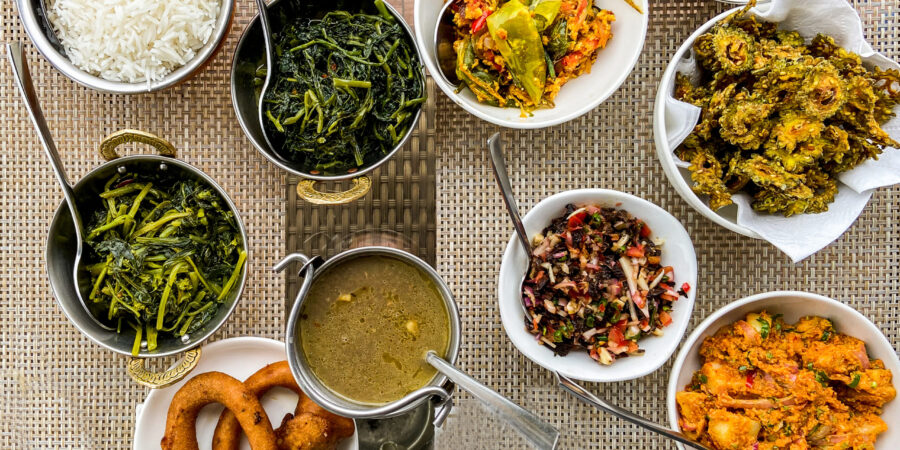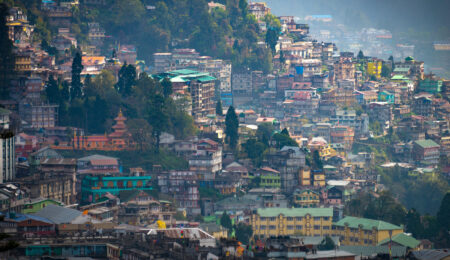 It is a culinary joy, providing a delightful assortment of local food that tantalises the taste buds and represents the rich cultural tapestry of the area. Darjeeling, which is nestled among the picturesque hills of West Bengal, is not only a refuge for stunning vistas, but it is also a gastronomic delight. As tourists make their way through the gorgeous alleys of Darjeeling, they start on a gastronomic trip that reveals the myriad of flavours and culinary traditions that are associated with this town.
It is a culinary joy, providing a delightful assortment of local food that tantalises the taste buds and represents the rich cultural tapestry of the area. Darjeeling, which is nestled among the picturesque hills of West Bengal, is not only a refuge for stunning vistas, but it is also a gastronomic delight. As tourists make their way through the gorgeous alleys of Darjeeling, they start on a gastronomic trip that reveals the myriad of flavours and culinary traditions that are associated with this town.
Darjeeling’s indigenous cuisine is a reflection of its eclectic background, inspired by the merger of Nepali, Tibetan, Bhutanese, and Bengali culinary traditions. As a result of the numerous cultural influences that have moulded Darjeeling’s culinary environment, the scrumptious options vary from substantial and flavorful to delicate and fragrant. This provides a gourmet experience that connects with the varied cultural influences.
When exploring the cuisine of Darjeeling, it is impossible to avoid trying the famous momos since they are a staple. The culture of the town’s street cuisine has become associated with these exquisite dumplings, which were influenced by the culinary traditions of Tibet. The momos, which have a thin and soft outer shell that encases a juicy interior of spiced meat or veggies, are sometimes served with a tangy dipping sauce that adds an additional layer of flavour to the dish. Momos are widespread and can be found anywhere, from street sellers to quaint cafés. They are a convenient and satiating snack that can be enjoyed by both residents and visitors alike.
In order to go on a more thorough gastronomic trip, it is necessary to explore the domain of traditional cuisines from Nepal and Bhutan. In Darjeeling, the fermented leafy green dish known as Gundruk and the thick, dough-like staple known as Dhido, which is prepared from either buckwheat or millet, are two examples of the culinary variety that flourishes in the region. These traditional meals, which are characterised by their one-of-a-kind textures and intense flavours, provide a look into the culinary legacy of the indigenous groups who reside in this area.
A leisurely walk through the bustling marketplaces of Darjeeling shows a plethora of fresh food and fragrant spices, which paves the way for the manufacture of mouthwatering regional specialties. Street food vendors, which provide a wide range of regional delicacies, bring the streets to life with their sizzling sounds and enticing aromas. Warming the soul with its aromatic broth and healthful ingredients, the traditional Thukpa, which is a substantial noodle soup of Tibetan heritage, is a dish that is considered. As one makes their way through the crowded marketplaces, the aroma of spices and curries that are cooking in the oven penetrates the air, beckoning one to explore and discover new gastronomic experiences.
A symphony of flavours that fascinate the senses can be found in Darjeeling’s indigenous sweets, which are perfect for individuals who have a need for something sweet. The classic Sel Roti, which is a traditional doughnut made from rice, is a beloved indulgence, particularly during celebrations and other joyful opportunities. This delicious delicacy, when accompanied by a cup of Darjeeling tea, transforms into a lovely interplay of textures and flavours, therefore reflecting the convergence of culinary traditions in the area.
The culinary tapestry of Darjeeling encompasses not just the street cuisine that is available there, but also the cosy and welcoming atmosphere that can be found in the local restaurants. Keventer’s, an establishment that dates back to the colonial period, is a living and breathing monument to the town’s ongoing culinary tradition. The food at this well-known restaurant, which is known for its panoramic vistas and vintage allure, is designed to pay respect to the many cultural influences that have shaped Darjeeling. Keventer’s offers a gastronomic refuge where flavours from other continents come together, and it serves everything from traditional Indian cuisine to English breakfasts.
Glenary’s, a colonial-style bakery and café that emanates an old-world charm, is yet another culinary treasure that is worth mentioning. Glenary’s invites guests to engage in a great culinary experience by providing them with a tempting selection of freshly baked products, exquisite pastries, and fragrant coffee. Savouring both regional and foreign delicacies is made possible by the establishment’s illustrious past and sophisticated atmosphere, which together provide the ideal setting.
For those who are looking for a dining experience that is really immersive, the Windamere Hotel, which is a well-known establishment, provides a gourmet trip through the culinary legacy of Darjeeling. The historic hotel, which dates back to the 19th century, is home to a sophisticated dining room that places an emphasis on the use of regional foods and traditional recipes. With a cuisine that has been carefully selected to highlight the wide range of Darjeeling’s culinary traditions, the restaurant provides a refined dining experience that is set against the background of colonial allure.
In Darjeeling, the colourful Mahakal Market, which is a buzzing centre of indigenous flavours, offers a genuine look into the city’s gastronomic scene. Those who are keen to discover and experiment with local delicacies will find the market to be a treasure trove, since it has a wide variety of fresh vegetables as well as fragrant spices. Visitors are invited to immerse themselves in the rich tapestry of Darjeeling’s culinary legacy by taking advantage of the market’s sensory feast, which is created by the market’s bustling environment and broad selection of local sellers.
While in Darjeeling, it is essential to join in the custom of drinking the region’s world-famous tea in order to truly enjoy the food that is native to the area. Several of the charming tea houses and estates, such as the Makaibari Tea Estate and Nathmull’s Tea Room, provide a sophisticated experience for those who want to sample tea. Visitors are able to immerse themselves in the tranquil atmosphere of the tea gardens while sampling a selection of Darjeeling teas, each of which has its own distinctive flavour profile and scent.
However, the gastronomic adventure in Darjeeling is not restricted to traditional dishes; rather, it also incorporates influences from throughout the world, which reflects the international nature of the town. Glenary’s and Kunga Restaurant are two examples of restaurants that highlight the blending of regional flavours with foreign cuisines. These restaurants appeal to a wide variety of palates and tastes.
When the sun goes down behind the Himalayan ranges, the restaurants in the town come to life with the warm glow of ambient lighting, providing a mystical setting for dining in the evening. The Laden La Road, which is surrounded by quaint cafés and restaurants, transforms into a gourmet promenade where both residents and visitors congregate to savour the evening and enjoy the flavours of Darjeeling.
All things considered, Darjeeling’s regional cuisine is a gourmet adventure that goes beyond the simple act of eating. On the one hand, it is a celebration of the town’s culinary heritage, on the other, it is a reflection of historical influences, and it is a celebration of cultural variety. Darjeeling is a town that welcomes visitors to go on a gastronomic journey that resonates with the town’s dynamic character and enticing flavours. From the tantalising scent of momos on the streets to the polished elegance of cafes that date back to the colonial period, Darjeeling is a place that offers culinary adventures. It is a place in which each mouthful conveys a narrative, and each meal is a symphony of flavours that remains in the mind, therefore producing a gastronomic tapestry that is as varied and entrancing as the hills that surround Darjeeling.





